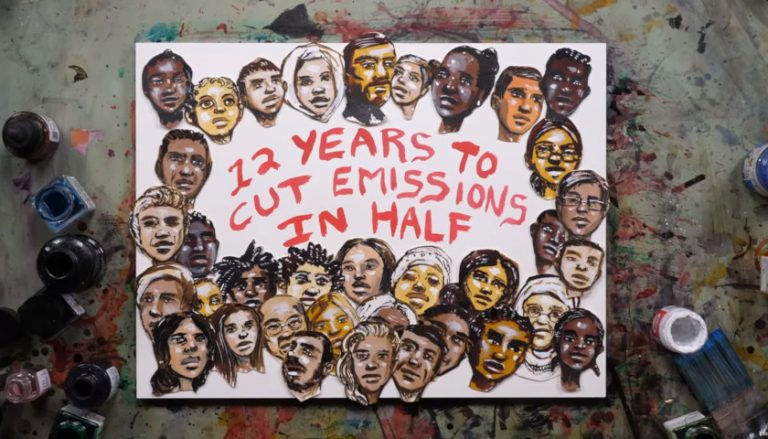A Message From the Future With Alexandria Ocasio-Cortez (video)
Naomi Klein et al, The Intercept
Today, The Intercept launches “A Message From the Future With Alexandria Ocasio-Cortez,” a seven-minute film narrated by the congresswoman and illustrated by Molly Crabapple. Set a couple of decades from now, it’s a flat-out rejection of the idea that a dystopian future is a forgone conclusion. Instead, it offers a thought experiment: What if we decided not to drive off the climate cliff? What if we chose to radically change course and save both our habitat and ourselves?
What if we actually pulled off a Green New Deal? What would the future look like then?
This is a project unlike any we have done before, crossing boundaries between fact, fiction, and visual art, co-directed by Kim Boekbinder and Jim Batt and co-written by Ocasio-Cortez and Avi Lewis. To reclaim a phrase from House Speaker Nancy Pelosi, it’s our “green dream,” inspired by the explosion of utopian art produced during the original New Deal.
(17 April 2019)
The video got more than 4 million views in the first 24 hours that it was up. -BA
Could a Green New Deal Make Us Happier People?
Kate Aronoff, The Intercept
For as long as climate change has been a part of America’s national consciousness, it’s been talked about in dire terms, evoking images of some hellish, “Mad Max”-style dystopia…
In describing the nature of the problem, drastic terms are of course necessary. Annihilation looms, and the chaos it threatens to bring about — stronger storms, more fearsome floods, unbearable heat — is truly the stuff of nightmares. But the apocalyptic framing of the problem has also shaped how we talk about solutions to it. From carbon taxes to consumption cuts, climate policy has long been framed as an issue of stiff-lipped sacrifice: What will we have to give up to save our skins? The right takes this characterization to extremes, accusing climate hawks of wanting to ban cars and hamburgers and throw civilization back into the Dark Ages.
While its critics like to pretend otherwise, the Green New Deal — an economy-wide mobilization to decarbonize the United States as soon as possible — turns that question on its head, asking instead where we need to invest society’s vast resources.
But could a plan to curb emissions also make us happier? Could the things we cut back also be the things that make us miserable?
…There are some obvious reasons to believe that a Green New Deal — the only call for that on the table — will make us happy, at least in the long run. Averting civilizational collapse, that is, is a happier outcome than the alternative. Provisions like a federal job guarantee, improved public transportation, and reining in pollution could improve millions of lives in the shorter term. A growing body of research, though, points to some more unexpected reasons why a Green New Deal could make us more cheerful.
The most recent entry on this front is a forthcoming paper from economists Anders Fremstad and Mark Paul. Looking at household-level data on work hours and household purchasing habits from the Consumer Expenditure Survey, they then calculate the carbon intensity of that spending to produce individual carbon footprints for each of the households surveyed. Fremsted and Paul find that people who work less also emit less carbon dioxide.
The punchline here isn’t novel; economist Juliet Schor has been drawing connections between work hours and climate change for well over a decade …
(9 April 2019)
She, The People: Meet Rhiana Gunn-Wright, An Architect Behind The Green New Deal
Donna M. Owens, Essence
Rhiana Gunn-Wright was always curious about policy, even before she fully understood the term.
“Growing up I’d wonder about structures—in my neighborhood and schools,” the 29-year-old South Side Chicago native told ESSENCE. “What are the rules, who made the rules? You can’t just look at the surface.”
Raised by her mother, grandmother, extended family, and a caring “village,” the Yale grad and Rhodes Scholar now seeks to answer the questions she had in childhood as a national policy expert. A onetime White House intern for former First Lady Michelle Obama, she’s lent her expertise to the Detroit Health Department, the Institute for Women’s Policy Research, and the 2018 gubernatorial campaign of Abdul El-Sayed in Michigan.
… her profile has risen even more lately, as one of the lead policy gurus behind the Green New Deal—a sweeping plan to tackle climate change, jobs and justice.
(17 April 2019)
Rhiana Gunn-Wright is African-American. -BA
Degrowth: a theory of radical abundance
Jason Hickel (University of London, UK)
real-world economics review, issue no.87
As the climate crisis worsens and the carbon budgets set out by the Paris Agreement shrink, climate scientists and ecologists have increasingly come to highlight economic growth as a matter of concern. Growth drives energy demand up and makes it significantly more difficult and likely infeasible for nations to transition to clean energy quickly enough to prevent potentially catastrophic levels of global warming. In recent years, IPCC scientists have argued that the only feasible way to meet the Paris Agreement targets is to actively scale down the material throughput of the global economy. Reducing material throughput reduces energy demand, which makes it easier to accomplish the transition to clean energy.
Ecological economists acknowledge that this approach, known as degrowth, is likely to entail reducing aggregate economic activity as presently measured by GDP. While such a turn might seem inimical to human development, and indeed threaten to trigger a range of negative social consequences, proponents of degrowth argue that a planned reduction of throughput can be accomplished in high-income nations while at the same time maintaining and even improving people’s standards of living. Policy proposals focus on redistributing existing income, shortening the working week, and introducing a job guarantee and a living wage, while expanding access to common goods.
Copyright: Jason Hickel 2019
(19 March 2019)
You may post comments on this paper at https://rwer.wordpress.com/comments-on-rwer-issue-no-87/





